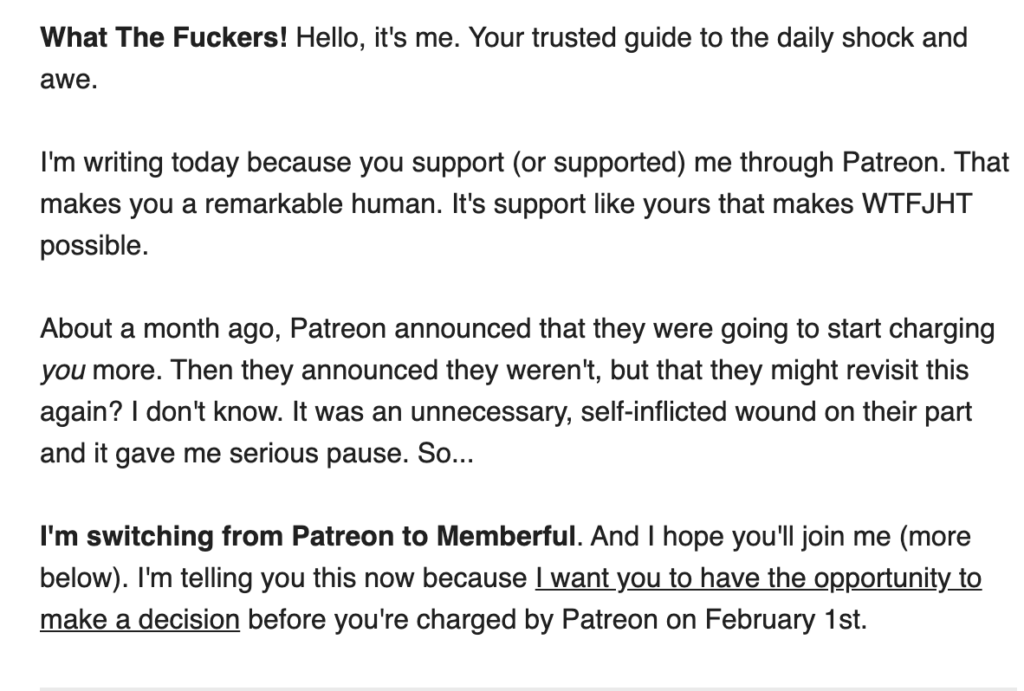Newsroom overview
WTF Just Happened Today is a newsletter, blog, and community chronicling the "daily shock and awe in national politics"
Seattle, Washington
2017
2017
100 percent
Matt Kiser launched WTF Just Happened Today? as a side project in 2017 in the earliest days of the Trump administration. As the project took off, readers asked how they could support the newsletter, which, as its name suggests, is a daily recap of what happened that day in national politics.
Kiser set up a PayPal account for the project for contributions. But as the project continued to grow, Kiser decided to quit his job and focus full-time on the effort. To grow the revenue needed to make it possible for him to run WTFJHT full-time, he launched a tiered membership program on Patreon. He soon realized that the platform wasn’t working for him, and migrated to a new system. Even today, years later, he’s still dealing with the legacy of that decision.
“From the jump, I screwed up,” Kiser said.
Why this is important
No matter the reason or type of platform, migrating from one tech service to another is a headache. Kiser is now on his fourth payment system since creating WTF Just Happened Today? three years ago. Even though he asked users to migrate their information to the new systems, many didn’t so he still has to maintain the old systems, which is a drain on his time and resources.
Publishers’ needs change over time, of course, but member-driven news organizations can save themselves a lot of trouble by considering potential growth and future use-cases as they make decisions about their tech stack. Kiser’s experience with payment systems is a cautionary tale for why these processes are so critical.
“That’s one of the biggest decisions you can make,” he said. “What kind of platform lock in are you willing to accept?”
What they did
As WTFJHT began to attract a following, Kiser set up a PayPal account so people could support the project with a pay-what-you-want model. And as he quit his job to run the newsletter full-time beyond the planned duration of the Trump administration’s 100 days, he added the Patreon, where he set-up a tiered membership system.
By April 2017, nearly 1,500 members were supporting Kiser with nearly $8,000 per month in funding via Patreon. But the system wasn’t working for him.
In addition to processing payments, Patreon offers its users a suite of tools to enable them to post updates, communicate with their supporters, and more. But Kiser wasn’t using any of those features and the fees the platform charged were eating into his revenue.
For example, on a $1 credit card charge, 10 percent was going to Patreon and 5 percent was going to credit card fees. Then, 10 cents would be charged for the payment processor’s cut. Between all that, WTFJHT would only get 35 or 40 cents from that member’s contributions.
“Obviously, the more you charge the less of a percent that becomes, but it was a huge amount of money,” Kiser said. “It would have been great if all of my product and service was held within Patreon. As if I was taking advantage of and using their tools to post and podcast and send newsletters, but I wasn’t. I was doing all of that elsewhere.”
Kiser didn’t want to use Patreon’s editorial tools, and by January 2018, he decided to do a “crazy thing” and move to Memberful, a membership platform that connects users’ website, Stripe, and MailChimp accounts. Memberful handles all the automations and forms required to interact with Stripe and creates documentation such as receipts, but critically, WTFJHT maintains ownership over the payment processing data via Kiser’s stripe account, so he would easily be able to move it from one platform to another.
When he decided to switch, he sent an email to all his paying supporters explaining the decision and asking them to cancel their Patreon payments and move to Memberful. He decided to still maintain Patreon for members who wanted to stay there or didn’t respond to his request because he didn’t want to lose their financial support.

He explained to members that “I just hit this point where I’m burning your money on a platform I’m not using. I already feel guilty asking you for money as it is, so let’s become more efficient. Let’s reduce our costs. This is how we’re going to do this.”
The results
“A huge number of people” canceled their Patreon contributions and moved over to Memberful, Kiser said. By April 2019, only 734 supporters remained on Patreon.
Now, 66 percent of WTFJHT’s members are on Memberful, 19 percent use PayPal, 10 percent remain on Patreon, and 5 percent contribute via DonorBox.
But Kiser has systems on all the platforms to allow people to make adjustments to their membership, cancel or change their credit cards, or update other personal information. To maintain those legacy systems on PayPal and Patreon, Kiser uses Zapier to keep emails up-to-date in MailChimp.
“It’s a bear to maintain sometimes because it occasionally breaks, and Zapier isn’t exactly cheap,” he said. “But what are you going to do? Are you just going to be held hostage to a platform and pay whatever their increasing fees are to not use their platform? Or do you take things into your own hands and do what’s best by the business and take that risk?”
The payment platform Donorbox supports payment for readers who come to WTFJHT’s website via an embedded form at the bottom of every daily update since neither Memberful or Patreon offered an embeddable option.
What they learned
Consider platform lock-in. As you’re making vendor choices, one of the things you’ll want to consider is who maintains the connection between the member and your organization. The key data points you want to consider are who owns the members’ payment information and the mode of contact, namely email address. You should carefully consider whether you need to maintain control of that data.
“That’s one of the biggest decisions you can make: what kind of platform lock in are you willing to accept? There are lots of people doing amazing stuff on Substack, but their aspirations are only to send a newsletter and have a public-facing pseudo blog,” Kiser said. “That’s totally cool, but you have to know what you’re getting into. While yes you can export the email addresses, you can’t export the people giving 10 bucks a month.”
Additionally, when you maintain control over your customer data, you can combine all your income from that member to get a holistic portrait of customer lifetime value. For example, when Kiser sells WTFJHT stickers on Gumroad, he’s able to export customer sales data and import it into the spreadsheet where he keeps other membership data, which allows him to piece together a more complete picture of a member.
“I can see how long they’ve subscribed, when they became a member, how much ‘extra’ revenue they’ve generated by way of t-shirts or sticker orders, etc,” he said.
Transparency triumphs. Members contribute because they believe in an organization’s work and they want to support its mission. If news organizations are up front with them and outline why their support is needed, members will be willing to chip in. The same principle applies when it comes to asking people to migrate to a new platform
When Kiser realized he needed to make a move that was critical for the long-term success of the newsletter, he explained it to his members. Most of them helped out by moving to Memberful themselves.
Respond to members. One of the reasons that Kiser chose Patreon is that it easily supports different membership tiers, which were initially a key offering of WTFJHT’s membership program. Each tier offered different pieces of swag — postcards! Stickers! A zine! T-shirts!
But fulfilling all those orders was eating into the time Kiser needed to actually produce the newsletter.
“I found that I was spending too much time at the post office, as well as spending too much money on physical goods,” he wrote on his FAQ. “After speaking with members, it became clear that while physical rewards are nice, the real reward is supporting the continued production of WTF Just Happened Today.”
By simplifying the membership offerings in response to member feedback, it made Kiser’s decision to move off of Patreon easier because he knew he wouldn’t be alienating core supporters.
Key takeaways and cautionary notes
Don’t feel stuck: Just because you initially thought one platform was right for your needs, it doesn’t mean you need to stick with it. There will inevitably be a bit of pain as you make transitions, but if it saves you money or improves the experience for your members or potential members by making it easier to pay or ensuring that the coverage is easier to access, it’s worth it. If you’re using a system that clearly isn’t working for you, and there are other viable options, the best thing you can do is switch — waiting will only cost you time and money.
Explain the process to your members. By giving your community a clear explanation for why you’re making a change, you can retain their trust and encourage them to help by taking any complicated steps you need them to take as part of the move. This advice applies to news organizations who are making a transition from being primarily a print subscription to primarily a digital membership, as Tiempo Argentino, Scalawag, and DoR have all had to do.
Data is 💰: As you consider vendors, do not make a choice until you know each vendor’s process for exporting data off of the platform.
Other resources
- WTFJHT post: WTFAQ: An overview of WTFJHT’s tech stack.


